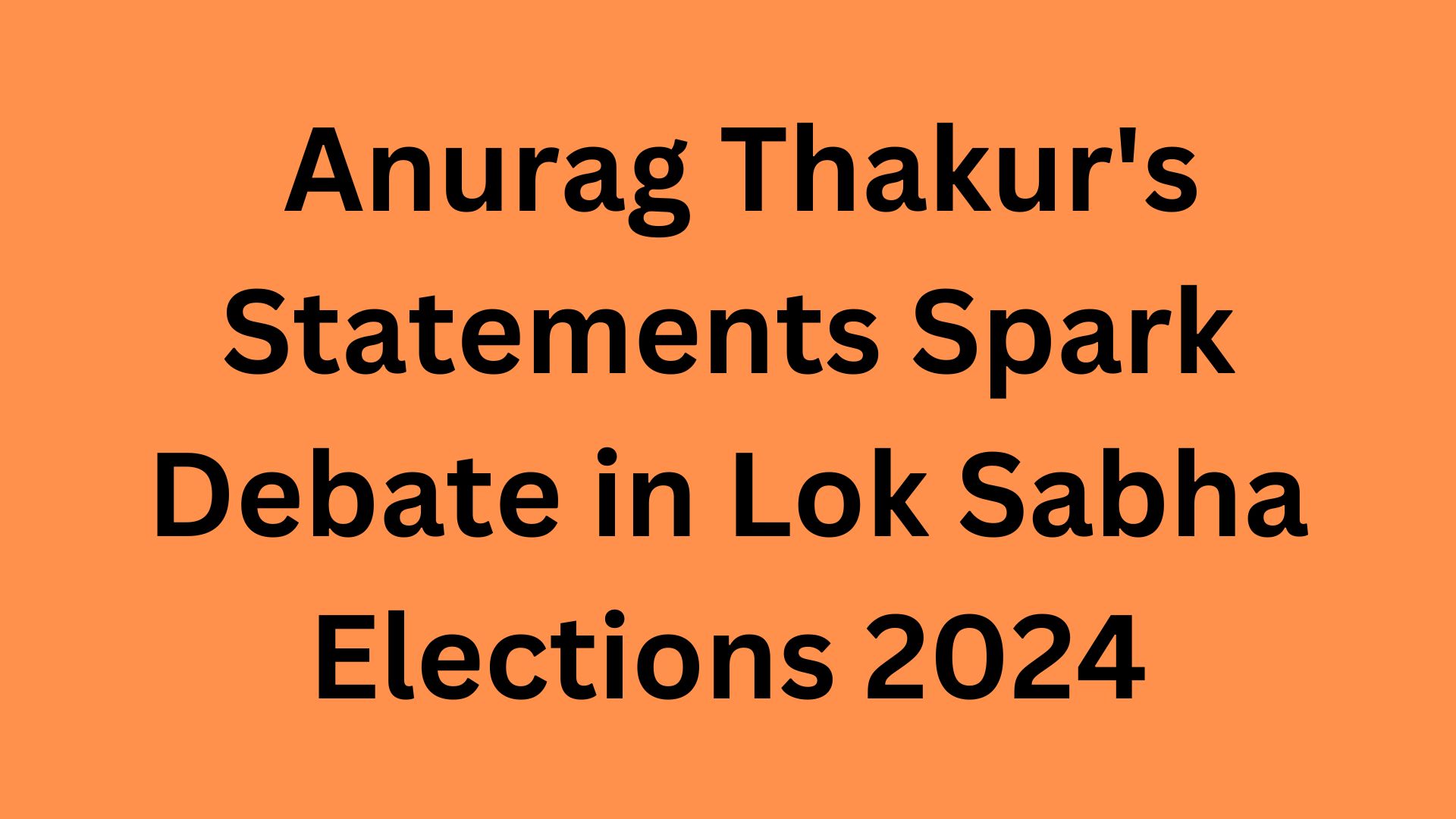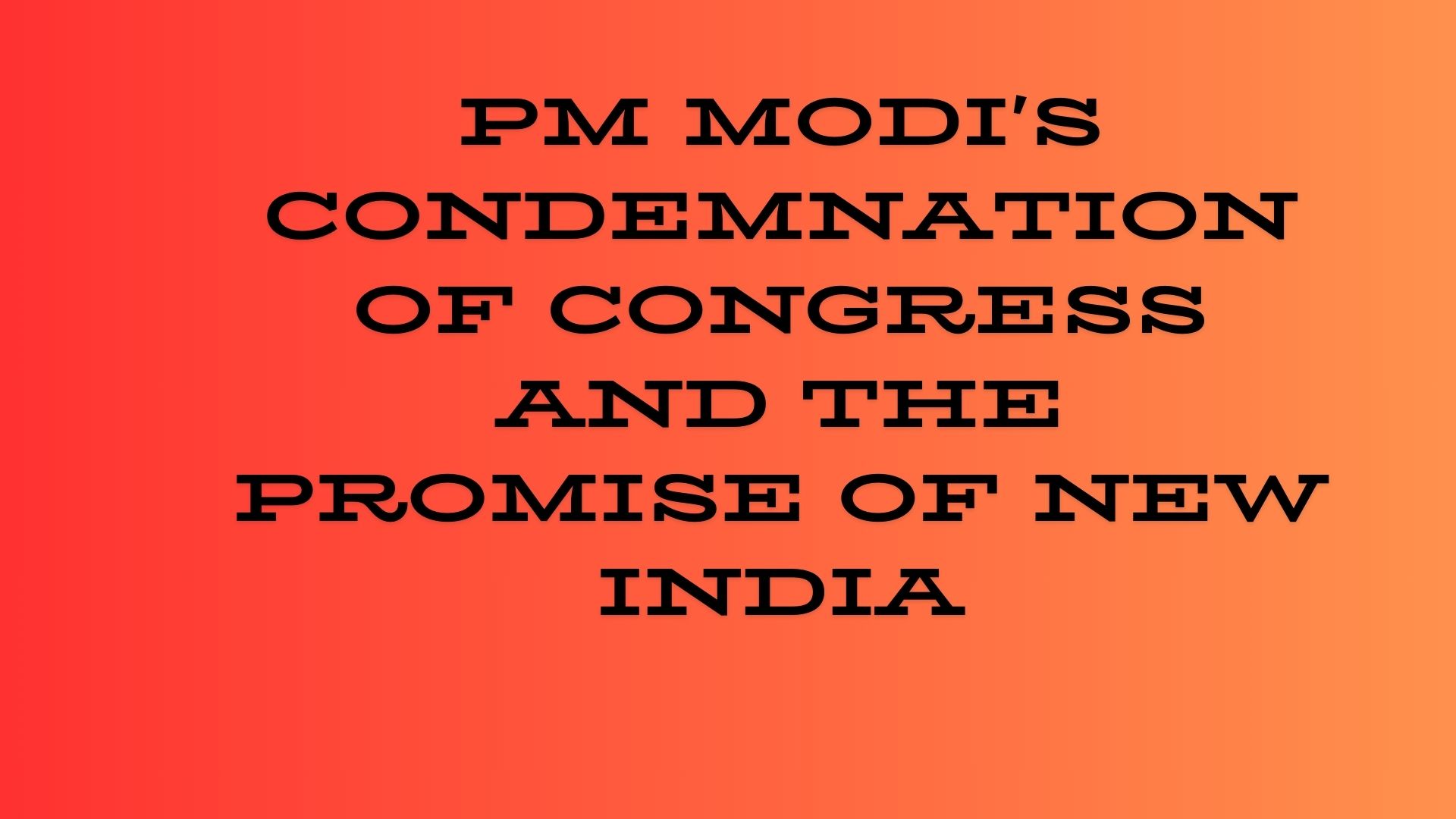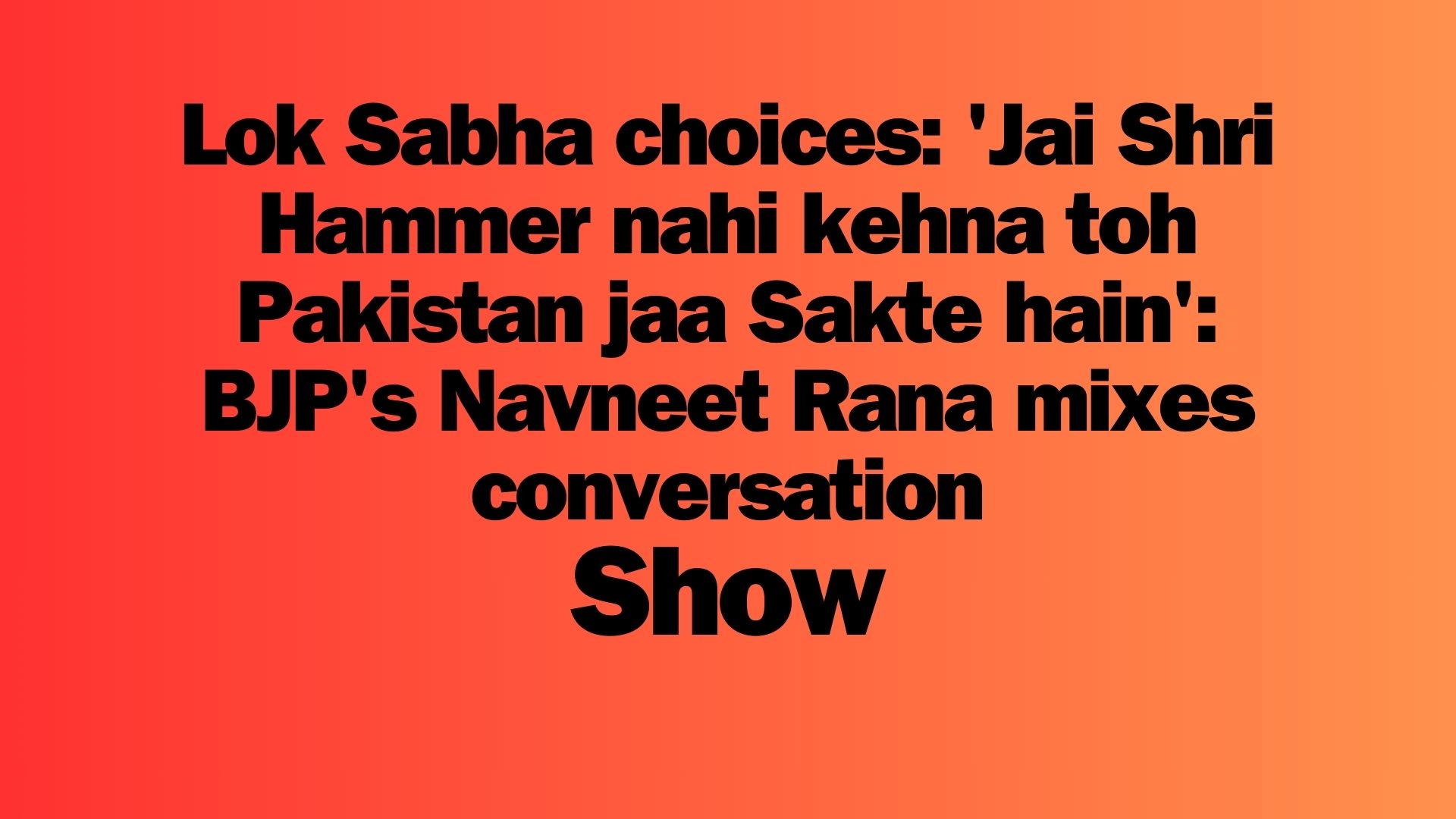Anurag Thakur’s Statements Spark Debate in Lok Sabha Elections 2024
Elections 2024: During the Lok Sabha Choices 2024 mission in Himachal Pradesh, Affiliation Minister Anurag Thakur made alarming charges against the Congress party, affirming that it gets support from Pakistan. The announcements were represented by the news site Amar Ujala, Blending conversation and touching off chitchats across political circles.
Anurag Thakur faulted the Congress party for having its announcement influenced by new capacities, particularly Pakistan. Watching out for the media at an event in Una area, Himachal Pradesh, Thakur denounced the Congress for partaking in administrative issues regardless, during times of public disasters and emergencies. He stood apart this system from the Bharatiya Janata Party’s (BJP) reasoning, emphasizing the BJP’s commitment to serving the country during crises.
Thakur complimented Top of the State Narendra Modi’s organization for its proactive work in giving assistance during stunning floods and rains in Himachal Pradesh. As a four-time parliamentarian, he highlighted the tremendous financial aide distributed by the Modi government to the state during ordinary disasters, portraying the BJP as a party focused on watching out for the necessities of people.
Anurag Thakur didn’t abstain from zeroing in on Congress pioneer Rahul Gandhi, reprimanding him for testing races from various electorates. Thakur disparaged Gandhi for apparently neglecting to recall his own brand name of “daro mat” (don’t be anxious) and faulted him for running, beginning with one seat, then onto the following, out of fear of defeat in the constant general races.
Anticipating the destruction of the Congress party in the looming choices, Thakur attested that their dreams of win considering sham responsibilities would be broken. He imparted trust in the BJP’s constituent prospects, particularly in Himachal Pradesh, where he is testing the Lok Sabha races in 2024 from the Hamirpur seat.
Thakur transmitted optimism about his own victory, communicating his confidence in safeguarding a resonating success with an edge more imperative than his past victory edge of around four lakh votes. He in like manner, he conveyed confidence about the BJP-drove Public Vote based Plot winning more than 400 seats in the Lok Sabha choices.
All things considered, Anurag Thakur’s cases against the Congress party and his confidence in the BJP’s constituent prospects reflect the charged climate of the Lok Sabha races 2024 mission. With a political approach to talking and parties seeking power, residents expect a dire part in embellishment the future course of Indian legislative issues.
Uncovering the Components of Lok Sabha Races: A Journey of Democracy
Introduction
The Lok Sabha Races in India are not just a political event; they are a celebration of a vote based framework, a display of assortment, and an impression of the nation’s total voice. As the world’s greatest democratic work out, Lok Sabha choices hold titanic significance, framing the course of India’s political scene and choosing the destiny of millions.
Unquestionable Setting and Improvement of India: A Trip Through Time
India’s undeniable setting and headway are just probably as various and flighty as the woven fine art of its lifestyle and progress. Spreading over hundreds of years, India’s arrangement of encounters is depicted by a rich weaving of improvements, domains, and social exchanges that have made an extremely durable engraving on its scene and character.
1. Old Civilizations
1.1 Indus Valley Civilization
1.2 Vedic Period
India’s arrangement of encounters follows back to the start of progress, with the out of date Indus Valley Advancement being one of the earliest metropolitan social orders known to mankind. The Vedic time span saw the ascent of sacred texts like the Vedas and the improvement of Hinduism as a critical severe and philosophical practice.
2. Customary Empires
2.1 Maurya Empire
2.2 Gupta Empire
The customary period saw the climb of strong domains like the Maurya and Gupta lines, which spread out monstrous political and social spaces across the Indian subcontinent. These spaces developed basic movements in workmanship, composing, science, and organization, laying out the preparation for India’s social legacy.
3. Middle age Dynasties
3.1 Delhi Sultanate
3.2 Mughal Empire
The antiquated period saw the methodology of Islamic rule in India with the groundwork of the Delhi Sultanate and later, the Mughal Domain. These lines presented a period of social syncretism, put aside by the blend of Indian and Islamic traditions in craftsmanship, plan, and composing.
4. Common Rule and Independence Struggle
4.1 English Raj
4.2 Independence Movement
The presence of European powers, particularly the English, announced one more segment in India’s arrangement of encounters with the colonization of the subcontinent. The fight for independence drove by remarkable figures like Mahatma Gandhi and Jawaharlal Nehru completed in India’s opportunity in 1947, meaning the completion of English rule and the presentation of the high level Indian nation state.
5. Post-Independence Era
5.1 Package and Improvement of India and Pakistan
5.2 Democratic Republic of India
The post-opportunity time saw the package of English India into India and Pakistan, provoking maybe of the greatest development in humankind’s arrangement of encounters and public strains that continue to form the region’s worldwide relations. India took on a vote based moderate constitution, setting up a strong groundwork for itself as a sovereign, socialist, normal, and democratic republic.
6. Current India: Troubles and Opportunities
6.1 Monetary Turn of events and Globalization
6.2 Social New development and Diversity
In the contemporary time, India has emerged as an overall monetary awe-inspiring phenomenon and a unique greater part controls government, grappling with the troubles of speedy urbanization, regular defilement, and monetary varieties. No matter what these challenges, India’s assortment, adaptability, and soul of headway continue to invigorate its journey towards progress and achievement.
India’s obvious setting and improvement are an exhibition of the adaptability and dynamism of its family, who have investigated through the repetitive example of history with superb flexibility and grit. As India strolls decisively into the future, its rich heritage and social legacy go about as a coordinating light, moving ages to come.
Beginning stages of Lok Sabha in India: Following the Beginning stages of Parliamentary Democracy
The beginning stages of the Lok Sabha, the lower spot of India’s Parliament, can be followed back to the traveler time when India was under English rule. The possibility of a representative regulative body created over an extended time, reflecting the longings of Indians for self-organization and democratic depiction.
1. English Trailblazer Rule
1.1 Show of Authoritative Councils
1.2 Confined Representation
During the English trailblazer time span, the Indian regulative collaboration began with the introduction of managerial loads up at the normal and central levels. Regardless, these sheets had limited capacities and were pervasively cautioning in nature, with little depiction for the Indian public.
2. Indian Social affairs Show of 1909
2.1 Advancement of Regulative Representation
2.2 Limited Elective Elements
The Indian Get-togethers Show of 1909, generally called the Morley-Minto Changes, meant an enormous step towards delegate organization by introducing confined elective parts in the regulative boards. This thought about the arrangement of specific people by a confined electorate including landowners, specialists, and picked neighborhood.
3. Interest for More imperative Representation
3.1 Climb of Indian Nationalism
3.2 Calls for Reliable Government
The mid 20th century saw the climb of Indian enthusiasm and calls for more unmistakable depiction and self-organization. Trailblazers like Bal Gangadhar Tilak, Gopal Krishna Gokhale, and Dadabhai Naoroji upheld for careful government and more essential collaboration of Indians in the definitive cycle.
4. Montagu-Chelmsford Changes of 1919
4.1 Show of Diarchy
4.2 Typical Regulatory Councils
The Montagu-Chelmsford Changes of 1919 introduced the possibility of diarchy, dividing liabilities between picked Indian ministers and English assigned experts in the districts. It furthermore expanded the powers of the authoritative chambers and introduced atypical races, preparing for more important Indian participation in the regulative cycle.
5. Organization of India Show of 1935
5.1 Normal Autonomy
5.2 Government Plan and Bicameral Legislature
The Public power of India Show of 1935 yielded colossal freedom to the districts and introduced an administration structure with a bicameral gathering at the center. While the Central Regulatory Social affair filled in as the lower house, the Leading body of States went probably as the upper house, establishing the groundwork for India’s future parliamentary structure.
6. Constituent Party and Gathering of the Constitution
6.1 Plan of the Constituent Assembly
6.2 Drafting of the Constitution
Following opportunity in 1947, the Constituent Social affair of India was depended with drafting the country’s constitution. The Constituent Social gathering embraced a parliamentary game plan of government, with the Lok Sabha spread out as the lower house, tending to the longing of people through direct choices.
The beginning stages of the Lok Sabha in India are pull in the fight for specialist organization and confidence. From its start as a commonplace time regulative load up to its improvement into the underpinning of India’s parliamentary democratic government, the Lok Sabha embodies the objectives and principles of a nation having a go at prominence based reinforcing and extensive depiction.
Uncovering the Headway of Constituent Cycle in India: From Custom to Technology
Introduction
The improvement of the constituent cycle in India is a charming journey that mirrors the country’s fame based ethos and mechanical movements. From standard methods for projecting a polling form to the gathering of best in class development, India’s constituent collaboration has gone through immense changes, ensuring more critical straightforwardness, efficiency, and inclusivity.
1. Standard Majority rule Methods
1.1 Voice Voting
1.2 Democratic structure Papers
In the early extended lengths of Indian greater part runs government, projecting a voting form was commonly driven through standard strategies, for instance, voice projecting a voting form and paper surveying structures. Residents would verbally report their choice or engraving their tendencies on paper casting a ballot structures, which were then genuinely developed to conclude the political race result.
2. Show of Electronic Popularity based Machines (EVMs)
2.1 Advantages of EVMs
2.2 EVM Execution Challenges
The introduction of Electronic Majority rule Machines (EVMs) improved the choosing framework in India by giving a more secure, exact, and useful popularity based part. EVMs considered faster counting of votes and restricted the bet of designated distortion, updating the reliability of the choosing framework. In any case, the execution of EVMs furthermore introduced challenges associated with particular failures to fire, security concerns, and resident trust.
3. Biometric Voter Verification
3.1 Show of Voter Undeniable Paper Audit Trail (VVPAT)
3.2 Biometric Check for Voter Identification
To extra work on the acceptability and straightforwardness of choices, India introduced biometric resident actually look at structures, for instance, the Voter Apparent Paper Survey Trail (VVPAT) and biometric affirmation for resident distinctive verification. These activities help with ensuring the accuracy of resident records, hinder emulate, and work on the overall decency of the constituent collaboration.
4. Online Resident Enrollment and Optional Management
4.1 Show of Online Balloter Registration
4.2 Modernized Designated Organization Systems
With the presence of development, India embraced electronic voter selection stages, allowing inhabitants to enlist as residents supportively from the comfort of their homes. High level Constituent Organization Structures were similarly familiar with smooth out the selective connection, working with endeavors like resident enlistment, promising new kid in town assignment, and result explanation.
5. Versatile Popularity based and Blockchain Technology
5.1 Examining Compact Majority rule Solutions
5.2 Gathering of Blockchain Technology
Advancements like flexible popularity based plans and blockchain development hold the likelihood to change the optional cycle in India also. Convenient majority rule applications could enable secure and worthwhile vote based from wherever, while blockchain advancement could redesign the straightforwardness and constancy of constituent records, lessening the bet of changing or control.
2. Designated System and Constituencies
2.1 First-Past-the-Post System
2.2 Electorate Delimitation
The Lok Sabha races follow a first-past-the-post structure, wherein promising new kids in town with the biggest number of votes in their specific electorates are broadcasted champs. Electorates are delimited considering people thickness, ensuring impartial depiction and relative apportioning of seats across regions.
3. Philosophical gatherings and Alliances
3.1 Multi-Party Democracy
3.2 Pre-Political race Alliances
India’s political scene is depicted by a multi-party structure, with an alternate bunch of get-togethers vieing for power and depiction. Pre-political race conspiracies and unions expect a dire part in trim optional outcomes, as often as possible reflecting key alliances and philosophical plans among political components.
4. Crusading and Balloter Engagement
4.1 Mass Arrangement and Outreach
4.2 Resident Guidance and Awareness
Lok Sabha choices witness exceptional doing combating and resident responsibility drives, with philosophical gatherings and candidates using various mediums to contact balloters. Mass actuation rallies, door to door missions, and virtual amusement outreach attempts are used to mix support and get ready residents, while resident tutoring programs mean to update care and collaboration in the representative cycle.
5. Constituent Communication and Voting
5.1 Political choice Commission Oversight
5.2 Electronic Vote based Machines (EVMs)
The chosen collaboration is addressed by the Political race Commission of India, an autonomous body depended with coordinating free, fair, and unbiased choices. Electronic Popularity based Machines (EVMs) are used to work with projecting a polling form, ensuring precision, capability, and straightforwardness in the constituent cycle.
## Conclusion
The Lok Sabha Choices in India are not just about picking delegates; they are a celebration of a vote based framework, a showing of the total will of people, and a reaffirmation of India’s commitment to greater part rule objectives. As the nation gears up for another optional occasion, the Lok Sabha choices continue to embody the spirit of a vote based framework, empowering occupants to shape the destiny of the country.
FAQs
What is the Lok Sabha?
The Lok Sabha, or the Spot of People, is the lower spot of the Parliament of India, including picked delegates from the country over.
How often are Lok Sabha races held?
Lok Sabha races are held at normal spans, with the exception of whenever broke down earlier, to pick people for the lower spot of Parliament.
What is the importance of Lok Sabha elections?
Lok Sabha races are vital as they choose the formation of the public power, shape regulative plans, and mirror the craving of people in a prominence based society.
How are Lok Sabha races conducted?
Lok Sabha races are driven through a multi-stage reviewing process, coordinated by the Political choice Commission of India, wherein qualified residents cast their votes to pick delegates from their different electorates.
What is the occupation of philosophical gatherings in Lok Sabha elections?
Philosophical gatherings expect a central part in Lok Sabha choices by dealing with promising new kids on the block, framing choosing methods, and planning residents to get constituent victories and depiction in Parliament.
What are Electronic Vote based Machines (EVMs), and how might they work?
EVMs are electronic contraptions used for anticipating and remembering votes in favor of choices. They contain a control unit and a balloting unit, and voters select their leaned toward rival by crushing a button close in their control on the surveying structure unit.
What is the Resident Obvious Paper Survey Trail (VVPAT) system?
The VVPAT system gives documentation to residents to affirm that their vote has been projected precisely. It delivers a paper slip with the voter’s choice, which is recognizable through a direct window before being saved in a decent box.
How has advancement further evolved resident enlistment in India?
Development has made balloter selection more favorable and open through web based stages. Occupants can now enlist as residents, update their nuances, and really take a look at their choosing status web, discarding the prerequisite for genuine visits to choosing work environments.
What are the troubles related with the gathering of new progressions in elections?
Troubles like specific discharge failures, network security risks, and voter preparing are connected with the gathering of new advances in races. Ensuring the security and uprightness of electronic popularity based structures and building public trust in them are fundamental examinations for selective trained professionals.
What occupation can blockchain development play in redesigning the choosing process?
Blockchain advancement might potentially work on the straightforwardness, security, and dependability of optional records by making painstakingly planned and long-lasting mechanized records. It might be used for tasks, for instance, resident selection, casting a ballot structure following, and result inspecting, reducing the bet of blackmail and control.



One thought on “From Manifestos to Foreign Allegations: Anurag Thakur’s Statements Spark Debate in Lok Sabha Elections 2024”